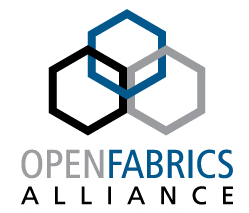Related Research Articles
Network File System (NFS) is a distributed file system protocol originally developed by Sun Microsystems (Sun) in 1984, allowing a user on a client computer to access files over a computer network much like local storage is accessed. NFS, like many other protocols, builds on the Open Network Computing Remote Procedure Call system. NFS is an open IETF standard defined in a Request for Comments (RFC), allowing anyone to implement the protocol.

InfiniBand (IB) is a computer networking communications standard used in high-performance computing that features very high throughput and very low latency. It is used for data interconnect both among and within computers. InfiniBand is also used as either a direct or switched interconnect between servers and storage systems, as well as an interconnect between storage systems. It is designed to be scalable and uses a switched fabric network topology. Between 2014 and June 2016, it was the most commonly used interconnect in the TOP500 list of supercomputers.

In computer science, inter-process communication (IPC), also spelled interprocess communication, are the mechanisms provided by an operating system for processes to manage shared data. Typically, applications can use IPC, categorized as clients and servers, where the client requests data and the server responds to client requests. Many applications are both clients and servers, as commonly seen in distributed computing.

A network interface controller is a computer hardware component that connects a computer to a computer network.

Server Message Block (SMB) is a communication protocol used to share files, printers, serial ports, and miscellaneous communications between nodes on a network. On Microsoft Windows, the SMB implementation consists of two vaguely named Windows services: "Server" and "Workstation". It uses NTLM or Kerberos protocols for user authentication. It also provides an authenticated inter-process communication (IPC) mechanism.
TCP offload engine (TOE) is a technology used in some network interface cards (NIC) to offload processing of the entire TCP/IP stack to the network controller. It is primarily used with high-speed network interfaces, such as gigabit Ethernet and 10 Gigabit Ethernet, where processing overhead of the network stack becomes significant. TOEs are often used as a way to reduce the overhead associated with Internet Protocol (IP) storage protocols such as iSCSI and Network File System (NFS).
In computer networking, DECserver initially referred to a highly successful family of asynchronous console server / terminal server / print server products introduced by Digital Equipment Corporation (DEC) and later referred to a class of UNIX-variant application and file server products based upon the MIPS processor. In February 1998, DEC sold its Network Products Business to Cabletron, which then spun out as its own company, Digital Networks, in September 2000.
iWARP is a computer networking protocol that implements remote direct memory access (RDMA) for efficient data transfer over Internet Protocol networks. Contrary to some accounts, iWARP is not an acronym.
The iSCSI Extensions for RDMA (iSER) is a computer network protocol that extends the Internet Small Computer System Interface (iSCSI) protocol to use Remote Direct Memory Access (RDMA). RDMA can be provided by the Transmission Control Protocol (TCP) with RDMA services (iWARP), which uses an existing Ethernet setup and therefore has lower hardware costs, RoCE, which does not need the TCP layer and therefore provides lower latency, or InfiniBand. iSER permits data to be transferred directly into and out of SCSI computer memory buffers without intermediate data copies and with minimal CPU involvement.

The OpenFabrics Alliance is a non-profit organization that promotes remote direct memory access (RDMA) switched fabric technologies for server and storage connectivity. These high-speed data-transport technologies are used in high-performance computing facilities, in research and various industries.
In computing the SCSI RDMA Protocol (SRP) is a protocol that allows one computer to access SCSI devices attached to another computer via remote direct memory access (RDMA). The SRP protocol is also known as the SCSI Remote Protocol. The use of RDMA makes higher throughput and lower latency possible than what is generally available through e.g. the TCP/IP communication protocol.

A storage area network (SAN) or storage network is a computer network which provides access to consolidated, block-level data storage. SANs are primarily used to access data storage devices, such as disk arrays and tape libraries from servers so that the devices appear to the operating system as direct-attached storage. A SAN typically is a dedicated network of storage devices not accessible through the local area network (LAN).
In computer science, memory virtualization decouples volatile random access memory (RAM) resources from individual systems in the data centre, and then aggregates those resources into a virtualized memory pool available to any computer in the cluster. The memory pool is accessed by the operating system or applications running on top of the operating system. The distributed memory pool can then be utilized as a high-speed cache, a messaging layer, or a large, shared memory resource for a CPU or a GPU application.

In computing, Linux-IO (LIO) Target is an open-source implementation of the SCSI target that has become the standard one included in the Linux kernel. Internally, LIO does not initiate sessions, but instead provides one or more Logical Unit Numbers (LUNs), waits for SCSI commands from a SCSI initiator, and performs required input/output data transfers. LIO supports common storage fabrics, including FCoE, Fibre Channel, IEEE 1394, iSCSI, iSCSI Extensions for RDMA (iSER), SCSI RDMA Protocol (SRP) and USB. It is included in most Linux distributions; native support for LIO in QEMU/KVM, libvirt, and OpenStack makes LIO also a storage option for cloud deployments.

Chelsio Communications is a privately held technology company headquartered in Sunnyvale, California with a design center in Bangalore, India. Early venture capital funding came from Horizons Ventures, Invesco, Investor Growth Capital, NTT Finance, Vendanta Capital, Abacus Capital Group, Pacesetter Capital Group, and New Enterprise Associates. A third round of funding raised $25 million in late 2004. LSI Corporation was added as investor in 2006 in the series D round. By January 2008, a $25M financing round was announced as series E. In 2009, an additional $17M was raised from previous investors plus Mobile Internet Capital.
RDMA over Converged Ethernet (RoCE) or InfiniBand over Ethernet (IBoE) is a network protocol which allows remote direct memory access (RDMA) over an Ethernet network. It does this by encapsulating an InfiniBand (IB) transport packet over Ethernet. There are multiple RoCE versions. RoCE v1 is an Ethernet link layer protocol and hence allows communication between any two hosts in the same Ethernet broadcast domain. RoCE v2 is an internet layer protocol which means that RoCE v2 packets can be routed. Although the RoCE protocol benefits from the characteristics of a converged Ethernet network, the protocol can also be used on a traditional or non-converged Ethernet network.

Mellanox Technologies Ltd. was an Israeli-American multinational supplier of computer networking products based on InfiniBand and Ethernet technology. Mellanox offered adapters, switches, software, cables and silicon for markets including high-performance computing, data centers, cloud computing, computer data storage and financial services.
RTP-MIDI is a protocol to transport MIDI messages within Real-time Transport Protocol (RTP) packets over Ethernet and WiFi networks. It is completely open and free, and is compatible both with LAN and WAN application fields. Compared to MIDI 1.0, RTP-MIDI includes new features like session management, device synchronization and detection of lost packets, with automatic regeneration of lost data. RTP-MIDI is compatible with real-time applications, and supports sample-accurate synchronization for each MIDI message.

SoftEther VPN is free open-source, cross-platform, multi-protocol VPN client and VPN server software, developed as part of Daiyuu Nobori's master's thesis research at the University of Tsukuba. VPN protocols such as SSL VPN, L2TP/IPsec, OpenVPN, and Microsoft Secure Socket Tunneling Protocol are provided in a single VPN server. It was released using the GPLv2 license on January 4, 2014. The license was switched to Apache License 2.0 on January 21, 2019.
SHMEM is a family of parallel programming libraries, providing one-sided, RDMA, parallel-processing interfaces for low-latency distributed-memory supercomputers. The SHMEM acronym was subsequently reverse engineered to mean "Symmetric Hierarchical MEMory”. Later it was expanded to distributed memory parallel computer clusters, and is used as parallel programming interface or as low-level interface to build partitioned global address space (PGAS) systems and languages. “Libsma”, the first SHMEM library, was created by Richard Smith at Cray Research in 1993 as a set of thin interfaces to access the CRAY T3D's inter-processor-communication hardware. SHMEM has been implemented by Cray Research, SGI, Cray Inc., Quadrics, HP, GSHMEM, IBM, QLogic, Mellanox, Universities of Houston and Florida; there is also open-source OpenSHMEM.
References
- ↑ RoCE Rocks over Lossy Network: https://dl.acm.org/citation.cfm?id=3098588&dl=ACM&coll=DL
- ↑ "Understanding iWARP" (PDF). Intel Corporation. Retrieved 16 May 2018.
- ↑ "DAT Collaborative website". Archived from the original on 17 January 2015. Retrieved 14 October 2014.
- ↑ The Interconnect Software Consortium website Archived 2005-08-30 at the Wayback Machine
- ↑ "Microsoft Based Solutions - Mellanox Technologies" . Retrieved 14 October 2014.
- ↑ "40Gbe SMB Direct RDMA Over Ethernet For Windows Server 2012 - Chelsio Communications". 2 April 2013. Retrieved 14 October 2014.
- ↑ "SOFA-STORAGE: CREATING A VENDOR AGNOSTIC FRAMEWORK TO ENABLE SEAMLESS STORAGE OFFLOAD USING SMARTNICS" (PDF).
- ↑ "What RDMA hardware is supported in Red Hat Enterprise Linux?". 2 June 2016.
- ↑ "40Gbe SMB Direct RDMA Over Ethernet For Windows Server 2012 - Chelsio Communications". Chelsio Communications. 2013-04-02. Retrieved 2016-07-15.
The demonstration will show Microsoft's Windows Server 2012 SMB Direct running at line-rate 40Gb using RDMA over Ethernet (iWARP).
- ↑ "Red Hat Enterprise MRG 2.0 Now Available". Archived from the original on 25 August 2016. Retrieved 23 June 2011.
- ↑ Storm: a fast transactional dataplane for remote data structures: https://dl.acm.org/doi/abs/10.1145/3319647.3325827
- ↑ Storm: a fast transactional dataplane for remote data structures: https://dl.acm.org/doi/pdf/10.1145/3319647.3325827